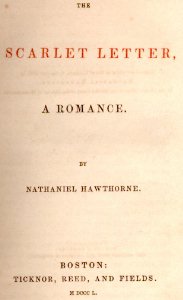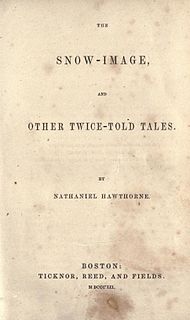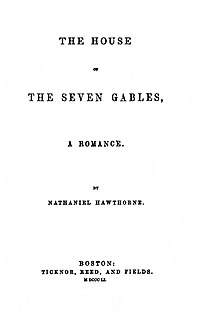
"The Great Carbuncle" is a short story by Nathaniel Hawthorne. It first appeared in December 1835 before being included in the collection Twice-Told Tales in 1837.

"The Great Carbuncle" is a short story by Nathaniel Hawthorne. It first appeared in December 1835 before being included in the collection Twice-Told Tales in 1837.
In the White Mountains, a band of eight adventurers gathers together. They are each on a personal quest for the Great Carbuncle, a brilliant gem legendary in its elusiveness. The adventurers are as follows:
The next morning, Matthew and Hannah wake up realizing that the others have left before them. Even though they fear they have lost the Carbuncle, they take their time in preparing for their morning's adventure. As they begin to climb a great mountain, they find themselves surrounded by the mists at its peak and fear that they will become lost. Spying a great red brilliance, though, they realize that the Carbuncle must be near and find it atop a cliff overlooking a lake. At the base of the cliff lies the Seeker, who has already died trying to reach the gem. The Cynic approaches and claims that he cannot see the Carbuncle; at Matthew's urging, he removes his spectacles and is permanently blinded by its brilliance. Matthew and Hannah decide to leave it where it is, knowing that it will overwhelm everything else in the world, and lead the Cynic down the mountain.
The story closes with an account of the other searchers' fortunes after this adventure:
Conflicting reports begin to spread as to the fate of the Carbuncle. Some accounts claim that it lost its luster and became an ordinary stone; others contend that it fell into the lake, and that the Seeker's spirit can sometimes be seen bending down toward it. A few people believe that the Carbuncle still retains its original glory and venture into the mountains after it – and the narrator reveals that he is one of them.
Hawthorne was informed by a trip to Vermont and New Hampshire beginning in September 1832. "The Great Carbuncle" was published in the December 1835 issue of The New-England Magazine as the second (and final) installment of his series "Sketches from Memory, By a Pedestrian", after "The Ambitious Guest" in the previous issue. [1] These two stories were among several of Hawthorne's works inspired by the White Mountains, along with his story "The Great Stone Face" and a nonfiction essay titled "Our Evening Party Among the Mountains". [2]
The story was republished as "The Great Carbuncle, a Mystery of the White Mountains" credited as "by the author of The Wedding Knell" in the annual The Token and Atlantic Souvenir in 1837. [3] It was finally published with the author's name in the compilation Mosses from an Old Manse (1846).
Hawthorne explores the importance of honesty, simplicity, and selflessness in "The Great Carbuncle." These positive characteristics are most often demonstrated by Hannah and Matthew during the search for the Carbuncle; they sacrifice personal gain, alter their goals, and pivot their actions to assist others for the good of the group.
By contrast, characters' selfish motivations and greed elicit negative results. Each character has their own fantasy related to the stone: Dr. Cacaphodel wants to publish his findings for profit, the cynic wants to prove that he's right, and the Poet wanted to keep it to insure his writing. Each of these characters meet a different tragic fate related to what they desired to use the stone for. The story reinforces Hawthorne's value of selflessness and simplicity as opposed to selfishness and greed.
This story also suggests that hard work and determination do not guarantee success. Though most of the characters are experts in their given fields, their knowledge does not help them at all.

Nathaniel Hawthorne was an American novelist, dark romantic, and short story writer. His works often focus on history, morality, and religion.
Cilix was, according to Greek mythology, a son of Agenor and Telephassa or Argiope and brother of Cadmus, Phoenix and Europa.

The White Mountains are a mountain range covering about a quarter of the state of New Hampshire and a small portion of western Maine in the United States. They are part of the northern Appalachian Mountains and the most rugged mountains in New England. The range is heavily visited due to its proximity to Boston, New York City, and Montreal.

The Old Man of the Mountain, also called the Great Stone Face and the Profile, was a series of five granite cliff ledges on Cannon Mountain in Franconia, New Hampshire, United States, that appeared to be the jagged profile of a human face when viewed from the north. The rock formation, 1,200 feet (370 m) above Profile Lake, was 40 feet (12 m) tall and 25 feet (7.6 m) wide.

The Scarlet Letter: A Romance is a work of historical fiction by American author Nathaniel Hawthorne, published in 1850. Set in Puritan Massachusetts Bay Colony during the years 1642 to 1649, the novel tells the story of Hester Prynne, who conceives a daughter through an affair and then struggles to create a new life of repentance and dignity. Containing a number of religious and historic allusions, the book explores themes of legalism, sin, and guilt.

"Young Goodman Brown" is a short story published in 1835 by American writer Nathaniel Hawthorne. The story takes place in 17th-century Puritan New England, a common setting for Hawthorne's works, and addresses the Calvinist/Puritan belief that all of humanity exists in a state of depravity, but that God has destined some to unconditional election through unmerited grace. Hawthorne frequently focuses on the tensions within Puritan culture, yet steeps his stories in the Puritan sense of sin. In a symbolic fashion, the story follows Young Goodman Brown's journey into self-scrutiny, which results in his loss of virtue and belief.

The Snow-Image, and Other Twice-Told Tales is a collection of short stories by American author Nathaniel Hawthorne. Released in late 1851 with a copyright of 1852, it is the final collection of tales by Hawthorne published in his lifetime.

James Renner is an American author, investigative journalist, producer, and director. He worked as a reporter for Cleveland Scene and was editor of the alternative newspaper The Cleveland Independent. He is known for his work in the thriller, science fiction, and true crime genres. In 2019, Renner founded The Porchlight Project, a nonprofit dedicated to offering support for the families of the missing and murdered.
The Great Stone Face is:

Twice-Told Tales is a short story collection in two volumes by Nathaniel Hawthorne. The first volume was published in the spring of 1837 and the second in 1842. The stories had all been previously published in magazines and annuals, hence the name.

Julian Hawthorne was an American writer and journalist, the son of novelist Nathaniel Hawthorne and Sophia Peabody. He wrote numerous poems, novels, short stories, mystery/detective fiction, essays, travel books, biographies, and histories.

The House of the Seven Gables: A Romance is a Gothic novel written beginning in mid-1850 by American author Nathaniel Hawthorne and published in April 1851 by Ticknor and Fields of Boston. The novel follows a New England family and their ancestral home. In the book, Hawthorne explores themes of guilt, retribution, and atonement, and colors the tale with suggestions of the supernatural and witchcraft. The setting for the book was inspired by the Turner-Ingersoll Mansion, a gabled house in Salem, Massachusetts, belonging to Hawthorne's cousin Susanna Ingersoll, as well as ancestors of Hawthorne who had played a part in the Salem Witch Trials of 1692. The book was well received upon publication and later had a strong influence on the work of H. P. Lovecraft. The House of the Seven Gables has been adapted several times to film and television.
"The Ambitious Guest" is a short story by Nathaniel Hawthorne. First published in The New-England Magazine in June 1835, it was republished in the second volume of Twice-Told Tales in 1841.

"Ethan Brand—A Chapter from an Abortive Romance" is a short story written by Nathaniel Hawthorne in 1850 and first published by Ticknor, Reed, and Fields in 1852 in The Snow-Image, and Other Twice-Told Tales, the author's final collection of short stories. Hawthorne originally planned a lengthy work about Brand, but completed only this piece. Hawthorne's inspiration was a lime kiln he saw burning while climbing Mount Greylock.

A carbuncle is any red gemstone, most often a red garnet.

Twice-Told Tales is a 1963 American horror anthology film directed by Sidney Salkow and starring Vincent Price.

The New-England Magazine was a monthly literary magazine published in Boston, Massachusetts, from 1831 to 1835.

"The Great Stone Face" is a short story published by Nathaniel Hawthorne in 1850. The story reappeared in a full-length book, The Snow-Image, and Other Twice-Told Tales, published by Ticknor, Reed & Fields in 1852. It has since been republished and anthologized many times.

The Crawford family of the White Mountains were a family who moved to New Hampshire's White Mountains in the 1790s from Guildhall, Vermont, and were pioneers in establishing a tourist industry in that area. Abel Crawford and his father-in-law, Eleazar Rosebrook, began the effort, and one of Abel's sons, Ethan Allen Crawford, made significant contributions. Another son, Thomas Jefferson Crawford, continued the work; and Ethan's wife, Lucy, also contributed. Their work was in the area then known as White Mountain Notch, subsequently called Crawford Notch.
Folktales about luminous gemstones are an almost worldwide motif in mythology and history among Asian, European, African, and American cultures. Some stories about light-emitting gems may have been based on luminescent and phosphorescent minerals such as diamonds.